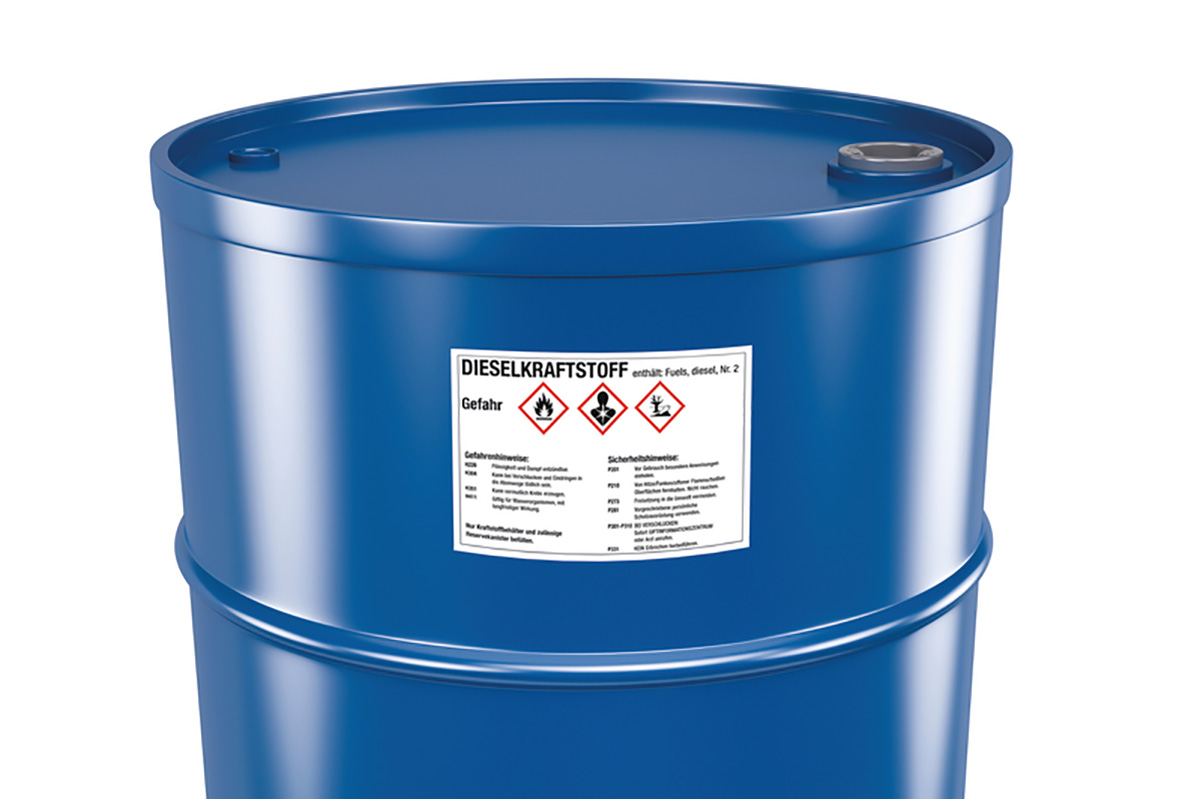GHS labels: durable and secure labelling of drums, barrels & more
Be on the safe side with HERMA labels based on the GHS
The usage scenario: labelling metal drums for overseas transport using hard-wearing GHS labels
Why is it important to have a global system for labelling chemicals?
Product and chemicals labelling in the chemical industry is subject to very strict legal regulations. The GHS regulation (CLP regulation) prescribes globally uniform guidelines as a system for the classification and identification of chemical substances. The purpose of GHS labelling is to protect people and the environment. An example is health hazards such as eye injuries.
GHS stands for Globally Harmonized System of Classification and Labelling of Chemicals (also called GHS labelling system or Globally harmonised system of chemical labelling). CLP stands for Classification, Labelling and Packaging of Substances and Mixtures. The GHS divides dangerous substances into classes represented by different hazard symbols (GHS labels pictograms). These classes are based on the properties of substances and mixtures. Examples are explosive, flammable, corrosive, oxidising and environmentally harmful.
GHS label requirements: in addition to their typical red diamond frames with black pictograms, GHS chemical labels contain the product code (name of the substance), a signal word, a hazard statement pertaining to the substance, information on environmentally hazardous forms of the substance and a precautionary statement relating to necessary measures in case of contact.
A particular challenge is that GHS hazard labels have only limited space for hazard statements, which means they must be printed in a small font. To ensure that the text is clearly readable, the GHS label material must be of high quality, permitting sharp printouts and excellent contrast.
GHS chemical drum labels with information on ingredients, real or potential hazards and classification must adhere securely to a wide variety of containers. Metal drums and metal containers are frequently used again and again.
These containers are stored both indoors and outdoors and are exposed to high temperature fluctuations and humidity. Exposure of the label GHS to UV radiation requires an exceptionally high lightfastness level for the printing inks. The painted surfaces of these containers may be soiled with grease, oil or dust.
The content is often filled hot, and acids, alkalis and solvents can usually be found on the surface of the metal drums.
This places exceptionally high demands on the adhesive of the label GHS, which must immediately adhere very securely, even under these extreme conditions. Environmental influences such as heat, humidity, cold and UV radiation raise the adhesive properties bar for the GHS label even more.
PE drums, canisters and IBCs with curved and frequently rough surfaces also require a very flexible and extremely hard-wearing label material for identification purposes.
For labelling when transporting dangerous goods by sea, approval is required in accordance with the British standard BS 5609.

The solution: GHS labels, made of PE film for laser printers and copiers, with extremely strong adhesion and seawater-resistance certification
Our sheet labels made of white matt PE film or PET film with extremely strong adhesive meet the particularly high chemical label requirements of the GHS labels application and are ideal for printing hazard / safety information on all laser printers and colour laser printers.
GHS labels: Saltwater-resistant as per BS 5609
The British Standard BS 5609 stipulates that the labels on hazardous substances and dangerous goods (GHS labels) must be able to be stored in saltwater for three months without becoming detached from the container. For sea and air freight, the law says that only packaging and containers with certified, saltwater-resistant, hazardous goods labels and hazardous substance labels should be transported. Drawing from our wide range of adhesive material, we can manufacture ready-to-use GHS labels that comply with the section of BS 5609, including Section 3.
One example is our material for single sheet usage, made of white matt PE film with an extremely strong adhesive, ideal for GHS labels::
- Weather-resistant, oil- and dirt-repellent
- Temperature-resistant from -40° C to +150° C
- Very flexible and stretchable, ideal for curved surfaces
- Excellent adhesion, even on dirty surfaces
- Excellent results on black & white and colour laser printers
Learn more about Seawater-proof, laserprint labels
GHS labels for individual re-printing with your printer
Other film labels from our in-house adhesive material production are also ideally suited for labels GHS. Pre-printed labels with GHS diamond frames in your label format are suitable for individual re-printing with your printer. Here high-quality printing results are essential on account of the small fonts often used for precautionary statements. According to the Blue Wool Scale, the coloured printing inks used for pre-printed red diamond frames have a lightfastness of 6-7. These labels for chemicals are also highly resistant to environmental conditions and have excellent adhesion. Depending on the type of printer, we will produce GHS labels for you in your desired format:
- On a roll for thermal transfer printers
- On a roll for inkjet printers with pigmented inks
- On A4 or A3 sheets as well as in special formats for black & white and colour laser printers
Seawater certification plus removability from re-usable containers
Sustainability and recycling are becoming increasingly important. Re-usable containers are being increasingly used in the chemical sector to conserve resources. GHS labels with the prescribed hazardous substance information (to fulfill the label requirements for chemicals) must, on the one hand, adhere securely to the surface to comply with the BS 5609 saltwater certification standard.
On the other hand, they must also be easy to remove from the surface before the containers are used again. The ideal solution for painted metal surfaces – HERMA GHS labels made of white, robust PET film with a strong adhesive that is nevertheless easy to remove.
Learn more about Seawater-resistant labels
![[Translate to English:] Perfekt bedruckbar mit Laser und Farblaser](/fileadmin/Industrieetiketten/Produkte/Gefahrstoff-Gefahrgut-Etiketten/Gefahrstoffetikett-auf-blauen-Faessern.jpg)
![[Translate to English:] Auch hohen Anforderungen gewachsen](/fileadmin/Industrieetiketten/Produkte/Gefahrstoff-Gefahrgut-Etiketten/Gefahrstoffetiketten-diverse-auf-farbigen-Behaeltern.jpg)

The main features of HERMA GHS labels for chemical containers
- Seawater-resistant as per BS 5609/II
- Weather-resistant, oil- and dirt-repellent
- Temperature-resistant from -40° C to +150° C
- Very flexible and stretchable, ideal for curved surfaces
- Excellent adhesion, even on dirty surfaces
- Excellent results on black & white and colour laser printers
- Customised label formats
GHS chemical labels: We’ll be happy to advise you!
Robust yet flexible films of different types, pressure-sensitive adhesive with a wide temperature range and application on different surfaces, light-resistant printing inks (Blue Wool Scale 6-7), plus perforation punching and printing as required. To buy GHS labels: Together with you, we will develop the GHS labels you need for identifying your chemical products – from the selection of materials all the way to the printing of the finished products.
Learn more about
On sheets, rolls or fanfolded: Blank labels
Hazardous substance labels and hazardous goods labels
Placards and hazard labels
Seawater-proof labels printed using thermal transfer printing
Solutions for Chemical labels
Track & trace in the chemical industry with chemical container labels
CLP labelling for chemical products: wrap-around labels
